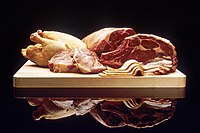
Photo from wikipedia
Abstract Consumers first assess the quality of roasted chicken meat by its appearance. However, studies that evaluate the color changes during thermal processing are lacking. The aim of this work… Click to show full abstract
Abstract Consumers first assess the quality of roasted chicken meat by its appearance. However, studies that evaluate the color changes during thermal processing are lacking. The aim of this work was, therefore, to develop a mathematical model that can predict the lightness (L*) changes of chicken breast meat during convective roasting. Chicken breast meat was roasted in a convection oven and the internal as well as surface lightness was measured at different time steps. The lightness of chicken meat increases in the beginning of the process, which shows a whitening due to myoglobin denaturation. When the surface temperature is rising above 88 °C, the lightness starts to decrease again as a result of browning reactions. We developed a non-isothermal kinetic model that describes the browning (decrease of the lightness) of the surface as function of temperature, water activity and roasting time. The kinetic models for the whitening and browning were then coupled to the validated mechanistic model for chicken meat roasting. This enables the prediction of the internal as well as surface lightness development from the spatial temperature and water activity changes. The validation of the model showed a good agreement between model predictions and experimental values for different roasting conditions. Overall, the developed model allows the prediction of the spatial lightness distributions with roasting time and advances our understanding of the mechanisms of heat induced color changes. Thus, the model can be applied to control and optimize the roasting of chicken meat to ensure the quality and safety for the consumer.
Journal Title: Food Control
Year Published: 2019
Link to full text (if available)
Share on Social Media: Sign Up to like & get
recommendations!